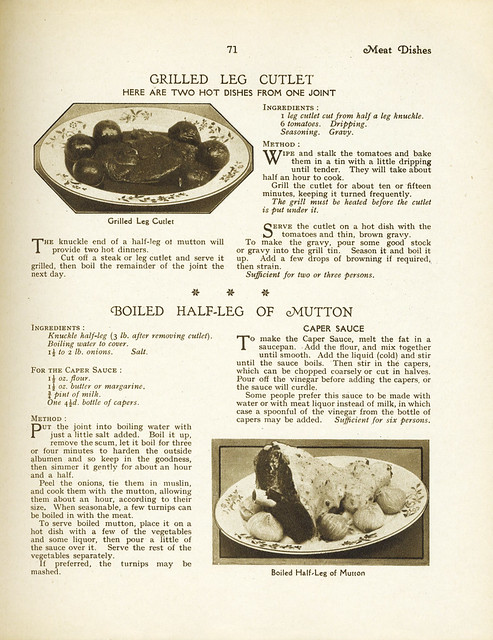Originally an English dish, mostly eaten in France these days, it seems.
I’m not quite sure why, but I'm rather curious about the old English dish of boiled mutton and caper sauce. Perhaps it’s a vision of the sort of people you see in Rowlandson cartoons or Hogarth paintings tucking into vast joints of meat, washed down with several pints of claret.
The Dinner. From 'The Comforts Of Bath'. Thomas Rowlandson (1756-1827).
Handcoloured Aquatint, 1798.
According to a 2014 BBC Radio 4 documentary, mutton was highly prized in England until the 19th century, but fell out of favour and was replaced by lamb. This was partly to do with the fact that good mutton was delicious, but poor quality mutton could be very tough, whereas lamb was more consistent in its quality. In the 1960s and 1970s, the invention of synthetic fabrics lead to reduced demand for wool, which pushed sheep rearing into further decline
There have been some efforts to promote a revival of mutton, but as far as I can tell it doesn't seem to have caught on so far. I haven’t seen it on restaurant menus except in stews, and they don’t sell mutton in my local supermarket. I might try to get it from a halal butcher. According to the radio programme, the mutton sold in halal shops is fresh, and not aged in the way it would be in the English tradition, but it's worth a try, I think.
I have, however, had boiled leg of lamb, from a recipe in French Home Cooking by Paul Bocuse.
Last weekend I thought it would be nice to have boiled leg of lamb, but the Bocuse cookbook had been packed away in anticipation of an impending house refurbishment, so I looked online for guidance. Based more or less on this recipe, I put chopped carrots, an onion studded with cloves, some celery, a head of garlic, a bay leaf, a bunch of parsley, and some fresh rosemary into a pot. I had planned to add a stock cube, but while shopping for the lamb, I found that my local Morrison’s supermarket had some lamb bones, so I used those instead. (My branch of Morrison’s are very good in that way: they regularly stock marrow bones, beef bones, chopped heart, and so on).
After adding water and bringing the whole lot to the boil, I simmered the lamb (a 1 kg leg portion, just right for two people) for about an hour. The recipe recommended 15-20 minutes per 500g but I had made a mistake and overdone it a bit. The meat was delicious and tender nevertheless. It's clearly a robust and forgiving method of cooking.
Previously, I had served the lamb with sauce gribiche, in accordance with the recipe in Bocuse. It had been a very good accompaniment but now I wanted caper sauce, which I had read about, but never before tasted. Using a recipe from the Guardian, I made the caper sauce with butter, cream, lamb stock from the cooking pot, parsley and lemon juice. I added rather more capers than they advised, which a good decision. The quantity of sauce was meant for eight people, but we found it about right for the two of us.
Served with boiled carrots and Jersey Royals, this was an excellent dish. I imagine the technique would suit the stronger and fuller flavour of mutton, and I must try that some time.
Just to finish off, this is a recipe I found on Flickr from the Bestway Cookery Gift Book (Fourth Book), published in 1929, in England.
I think a bit of French influence has been a good thing as far as this English dish is concerned.






No comments:
Post a Comment